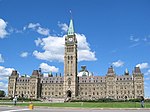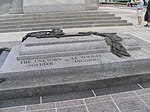Canadian Museum of Contemporary Photography

The Canadian Museum of Contemporary Photography (CMCP) (French: Le Musée canadien de la photographie contemporaine (MCPC)) was a gallery of Canadian contemporary art and documentary photography. Founded in 1985 and affiliated to the National Gallery of Canada (NGC), it was housed at the National Gallery of Canada, located at 380 Sussex Drive, Ottawa. The CMCP did not have a permanent home until it moved to its purpose-built site at 1 Rideau Canal in 1992. The Pavilion entrance building, which was opened on May 7, 1992, was originally proposed by architect Michael Lundhom, who adapted an old railway tunnel running alongside the Chateau Laurier. The museum ultimately was designed and executed by architects Rysavy Rysavy. The glass and concrete entrance from the street, reminiscent of the colonnade leading into the National Gallery, lead patrons down to the main part of the museum which was located below street level.Its founding director and chief curator was Martha Langford, who held those positions from 1985 until 1994.In 2009 it was announced that the CMCP, which had been closed temporarily in 2006, would be permanently closed. Its collections and program of exhibitions were absorbed by the National Gallery of Canada. In 2016, the CMCP's photographic collection was folded into the newly created Canadian Photography Institute (CPI).
Excerpt from the Wikipedia article Canadian Museum of Contemporary Photography (License: CC BY-SA 3.0, Authors, Images).Canadian Museum of Contemporary Photography
Rideau Street, (Old) Ottawa Rideau-Vanier
Geographical coordinates (GPS) Address Nearby Places Show on map
Geographical coordinates (GPS)
| Latitude | Longitude |
|---|---|
| N 45.425083 ° | E -75.695329 ° |
Address
Rideau Street 1
K1P 1C7 (Old) Ottawa, Rideau-Vanier
Ontario, Canada
Open on Google Maps





